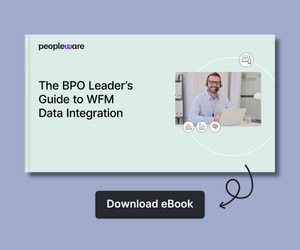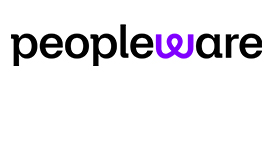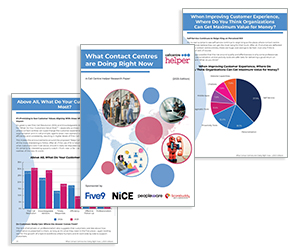Doug Casterton, on behalf of Peopleware, delves into the transformative power of customer journey-based workforce management, showing how aligning staffing strategies with customer needs at each stage can enhance efficiency.
What Is the Customer Journey?
In today’s contact centre, you need to deliver an appropriate and timely service to customers, whether they are prospective customers, new customers, mature customers, or evangelists.
And yes, you need to be prepared for the possibility that customers may think of leaving you, too. These different stages in the customer lifecycle are known collectively as the customer journey.
Customer Journey-Based WFM
Customer journey-based workforce management (WFM) is a strategy that aligns staffing calculations and schedules with the needs and expectations of customers at each stage of their journey with your organization.
Journey-based WFM focuses on understanding and optimizing the resources required to deliver exceptional customer experiences throughout that journey.
It covers all types of interaction, from signup to support requests, from renewal to complaint. You need to cover all the channels, from phone calls to web chats, emails, and social media posts.
This requires a different approach to traditional WFM, which places each step of the customer journey in a different ‘silo.’
The over-reliance on functional silos, like routing all Sales or Customer Service contacts to one single staffing group, is like trying to navigate modern-day London with a map from the 1800s.
The traditional WFM approach fails to deliver the optimal customer experience and productivity needed in today’s digital-first world.
The Power of Journey-Based Staffing
Efficiency That Matters
Moving from siloed teams to journey-based staffing isn’t just about reorganization; it’s about strategic resource allocation that delivers real results. Think of it as assembling a world-class football team: you wouldn’t put your star striker in goal, for example.
Moving from siloed teams to journey-based staffing can deliver substantial productivity improvements through strategic resource allocation. Here’s how:
- Handle Times For example, technical specialists could handle intricate product queries while generalists manage routine transactions, improving the time it takes to handle complex contacts.
- Contact Resolution By routing contacts to agents with the right expertise level, first contact resolution typically increases. This reduces costly repeat contacts and callback volumes that plague traditionally siloed models.
- Cost Management The strategic deployment of specialists versus generalists can optimize labour costs. For example, higher-paid experts focus solely on complex, high-value interactions, while lower-cost resources handle straightforward contacts.
- Agent Engagement Specialists handling contacts aligned with their expertise typically report higher job satisfaction and lower attrition. They spend more time doing what they do best rather than struggling with mismatched contacts.
The efficiency gains are compounded over time as teams develop deeper journey-stage expertise.
Customer Experience Improvements
When customers with complex issues connect with subject matter experts, magic happens. First-contact resolution rates climb, and CSAT scores follow suit.
For example, specialists trained in handling sensitive situations like billing disputes or service cancellations will demonstrate higher empathy levels and better de-escalation skills. This targeted approach reduces customer effort and frustration during emotionally charged interactions.
The key is matching the right expertise to high emotional or technical complexity moments. This ensures customers receive expert guidance when needed, building trust and loyalty through superior issue resolution.
How to Implement Customer Journey-Based WFM
Historical Pattern Analysis & Forecasting
Start by diving deep into your contact patterns. Map volumes and handle times to specific journey stages, like how a chess master studies game patterns. Track contact patterns across different touchpoints while considering channel-specific behaviours.
Your analysis should capture the following:
- Channel-specific handling variations by touchpoint
- Handle time by journey stage by touchpoint
- Seasonal pattern detection by touchpoint
- Yearly trends by touchpoint
- Weekly and daily patterns by touchpoint
- Special event impacts by touchpoint
For example, if your contact centre deals with retail-related contacts, you will want to map all interactions from pre-purchase research to post-purchase support. This isn’t just about counting contacts but understanding customer behaviour patterns.
Skills Inventory Assessment
A comprehensive skills inventory assessment is fundamental to journey-based WFM success. The process requires a systematic approach to mapping your talent pool against evolving customer needs. A detailed skills matrix should encompass the following:
- Technical & efficiency proficiency levels across product touchpoints
- Soft skills like empathy and de-escalation abilities
- In global organizations, language capabilities, and cultural competencies
Structure your workforce into focused specialist groups. Here are some examples of how you could do this:
For the Initial Contact Touchpoint
You might need specialists with exceptional active listening skills and the ability to build rapport quickly. They should also have a knack for asking the right questions to uncover the true nature of the customer’s inquiry.
At the Product Support Touchpoint
Technical wizards are your go-to here. Look for agents with deep product knowledge, troubleshooting expertise, and the ability to explain complex concepts in simple terms.
For Complaint Handling
This is where your empathy ninjas shine. You want agents with high emotional intelligence, conflict-resolution skills, and the ability to turn negative experiences into positive ones.
During Upselling or Cross-Selling Opportunities
Agents with strong sales skills, product knowledge, and the ability to identify customer needs are crucial here.
In Escalation Scenarios
You’ll want agents with strong problem-solving abilities, decision-making skills, and the confidence to handle complex issues.
For Post-Resolution Follow-Ups
Agents with attention to detail, proactive communication skills, and the ability to gather meaningful feedback are key.
Schedule Optimisation
Move beyond basic scheduling to create dynamic patterns that match customer journey touchpoints. This isn’t just about coverage… it’s about optimal coverage that aligns with customer needs and agent skills.
Real-Time Performance Monitoring
Stay ahead of the curve by anticipating volume and average handling time (AHT) patterns and preparing accordingly. Focus on these key metrics:
Journey-Stage Service Levels
Monitor service levels at each customer journey stage, not just overall. This granular view helps identify specific pain points and opportunities.
Skills Utilization
Track how effectively you’re using your skilled resources. Are your specialists spending time on general queries? Are your generalists struggling with complex issues?
Technology: The Enabler
Modern WFM requires modern tools. Here’s what you need.
Capturing Customer Intent
The foundation of journey-based workforce management lies in accurately understanding why customers reach out. Let me share two approaches to capturing customer intent effectively:
Simple Method
A straightforward IVR system with clear menu options lets customers self-identify their needs.
Structure your menu to mirror common journey touchpoints… for example, “Press 1 for pre-purchase questions, 2 for order status, 3 for technical support.” Keep it simple with no more than 4-5 options at each menu level to avoid customer frustration.
Advanced Method
Modern AI-powered intent detection takes customer understanding to the next level. By analysing customer messages across channels, voice, chat, and email, natural language processing (NLP) systems can:
- Automatically categorize contacts by journey stage
- Detect customer sentiment and urgency
- Identify complex vs simple queries
- Route to the right specialist group
The beauty of NLP is that it learns and improves over time, continuously refining its understanding of your unique customer journeys.
Automated Skill-Based Routing
Let technology do the heavy lifting. Automated skill-matching ensures you’re not just filling seats… you’re positioning the right talent at the right touchpoints.
Create flexible routing mechanisms that adapt to volume spikes and changing customer needs by overflowing contacts from one agent group to another.
This critical functionality ensures that you hit your service level goals while enjoying workforce economies of scale. It also ensures you do not burn staff out by overworking some agent touchpoint groups while underutilizing others.
A Modern WFM tool
The foundation of effective journey-based staffing relies on sophisticated WFM tools that can handle complex routing and forecasting scenarios.
Your WFM platform must support the following:
- Multi-skill forecasting with high accuracy down to granular interval level
- Dynamic overflow routing between agent groups
- Real-time adherence monitoring with skill-level insights
- Automated schedule optimization across multiple skill sets
The Path Forward
The future of contact centre WFM isn’t just about having warm bodies in seats. It’s about having the right skills available at the moments that matter most.
As someone who’s implemented these changes across multiple global organizations, I can tell you that the results are worth the effort. When you get this right, your metrics improve, your agents are happier, your operation runs more smoothly, and the bottom line gets better, too.
This blog post has been re-published by kind permission of Peopleware – View the Original Article
For more information about Peopleware - visit the Peopleware Website
Call Centre Helper is not responsible for the content of these guest blog posts. The opinions expressed in this article are those of the author, and do not necessarily reflect those of Call Centre Helper.
Author: Peopleware
Reviewed by: Jo Robinson
Published On: 27th Feb 2025
Read more about - Guest Blogs, Doug Casterton, Peopleware






 Peopleware is a leading workforce management (WFM) solution, trusted by over 500,000 users in 30+ countries. With smart forecasting, automated scheduling and real-time management, organizations can optimize workforce efficiency and keep work aligned with demand. From precise time tracking to flexible planning, Peopleware helps organizations boost operational efficiency and foster a more engaged, productive workforce.
Peopleware is a leading workforce management (WFM) solution, trusted by over 500,000 users in 30+ countries. With smart forecasting, automated scheduling and real-time management, organizations can optimize workforce efficiency and keep work aligned with demand. From precise time tracking to flexible planning, Peopleware helps organizations boost operational efficiency and foster a more engaged, productive workforce. 









